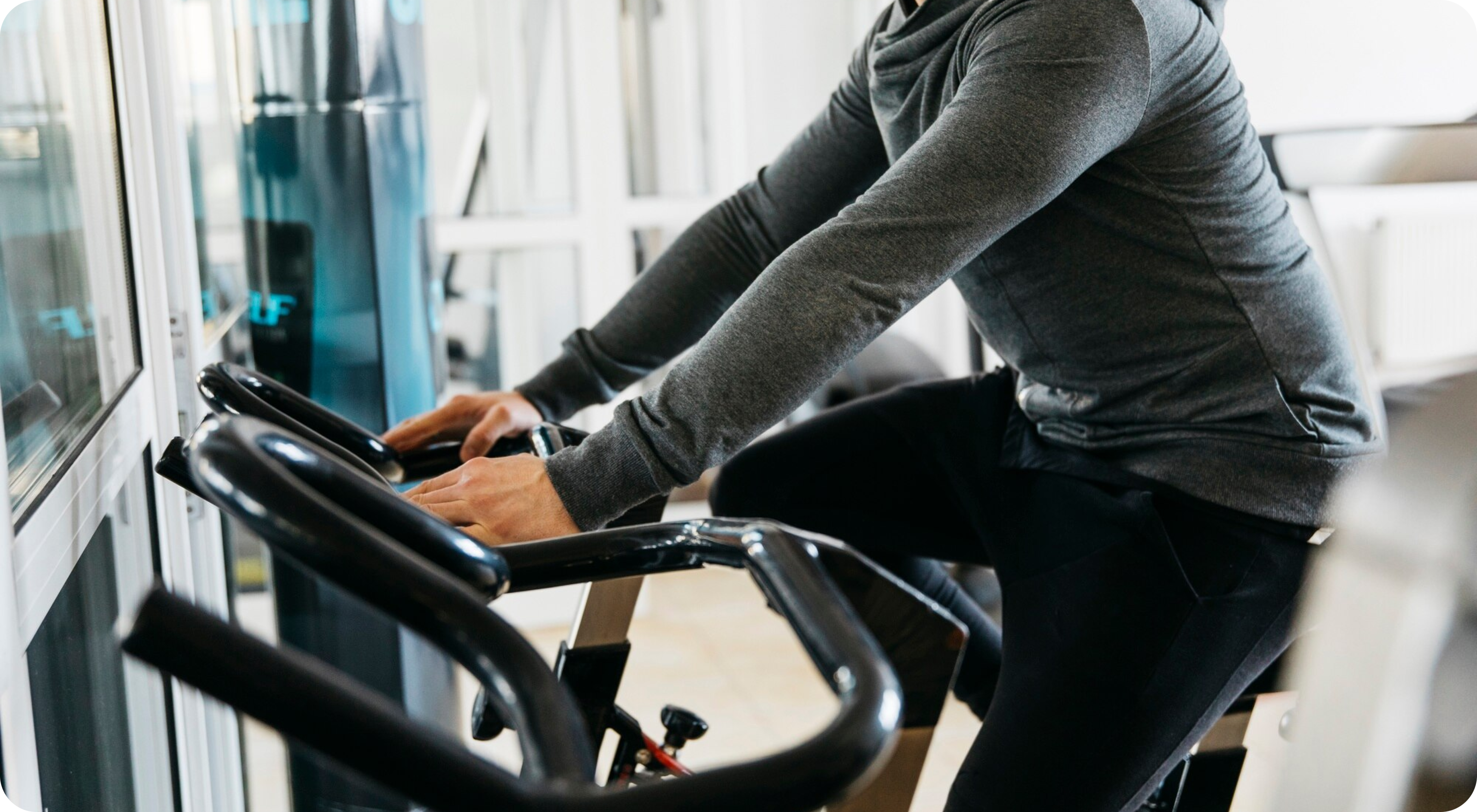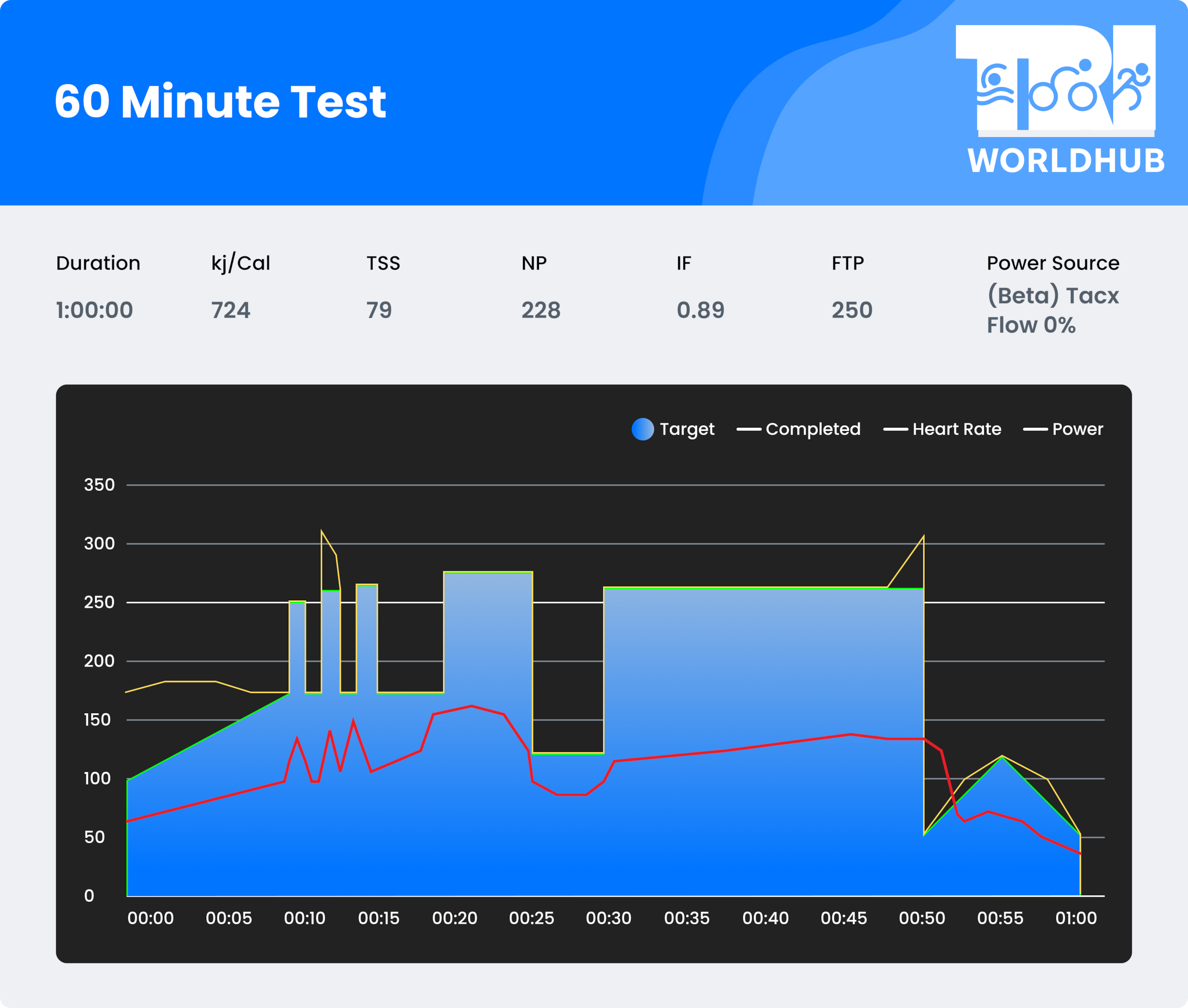Whether you’re a beginner or an experienced cyclist, FTP testing is crucial for power-based training.
When an athlete gets started cycling training, the first workout is usually an FTP test. There’s a fundamental reason for this.
By knowing your fitness level, you won’t overdo it or underdo it during your workouts.
Regardless of your fitness level, they’ll challenge you to achieve your fitness goals while still allowing you to maintain your fitness level.
An FTP test, short for Functional Threshold Power test, is a way to measure a cyclist’s fitness level. It’s like a benchmark to see how much power you can sustain on the bike for a certain time.
Let’s dive into what FTP is, why it matters, and how to do this test.
Understanding FTP: The Key to Power-Based Workouts
Functional Threshold Power, or FTP, is a crucial metric for cyclists.
It represents the highest power you can sustain for an extended period. Ideally, this means the maximum power you can maintain for an hour. However, in practice, most cyclists find it challenging to keep this effort for much longer than 30 minutes.
Physiologically, FTP is similar to your Lactate Threshold, the point where your body produces lactate at the same rate it removes it.
This balance allows you to sustain high efforts for longer periods, sitting in the sweet spot between a pace you can hold all day and the intense power you can only manage for a few minutes.
FTP forms the foundation for structuring power-based workouts, helping you train more effectively and measure your progress accurately.

3 Ways To Conduct a Functional Threshold Power Test
There are several methods to determine your FTP.
Here are three popular FTP tests:
20-Minute Test
The most popular way to test your FTP is with a 20-minute time trial.
In this test, you ride as hard as you can for 20 minutes. Your FTP is then calculated as 95% of your average power during that time.
Here’s how to do it:
Setup
Use a bike with a power meter or smart trainer and a device to track your power output.
Warm-up
Spend 10-15 minutes gradually increasing your effort. Start easy, then ramp up to get your muscles ready.
The Test
Ride as hard as you can for 20 minutes. Maintain a steady, tough pace — not a sprint. It should be a consistent, challenging effort.
Cool Down
After the test, cool down for about 10-15 minutes to help your body recover.
Calculate FTP
Take your average power for the 20 minutes and multiply by 0.95. That’s your FTP.
Another method to test FTP is the 8-minute test.
Here, you ride two 8-minute intervals as hard as you can, with a 10-minute rest in between. Your FTP is calculated as 90% of the average power of both intervals combined.
Ramp Test
The Ramp Test is another quick and efficient way to estimate your FTP.
It’s done in steps that last 2-4 minutes, where you ride at a steady power level. After each step, you increase the power by about 25 watts without stopping. You keep doing this until you can’t maintain the power anymore.
The test usually starts at 75 watts, but this can change based on your fitness level.
When you can’t keep up the power, the test ends.
Calculate FTP: the training software or device you’re using will calculate your FTP power based on your performance, taking the average power from the last minute of your test and multiplying it by 0.75 to find your FTP.
Ramp tests are shorter and less demanding than other methods, making them easier to complete.
It’s especially useful for beginners or those who prefer a quicker test. However, it might be less precise for experienced cyclists.
60-Minute Test
The 60-minute test is considered the gold standard for determining FTP because it reflects the true maximum power you can sustain for an hour.
Here’s how this traditional FTP test is done:
Start with a comprehensive warm-up to prepare your muscles.
Ride as hard as you can for a full 60 minutes. Aim to maintain a steady effort throughout training zones.
Keep an eye on your power output, pacing yourself to avoid burning out too early.
Calculate FTP: your FTP is simply your average power over the one-hour test.
This method is the most accurate because it directly measures the effort you can sustain for an hour.
However, it’s also the most demanding and can be mentally and physically challenging to complete.
It requires excellent pacing and concentration to avoid starting too hard and fading before the end.
How Much Calories Can You Burn During One Hour FTP Test?
The number of calories burned during a one-hour FTP test depends on several factors.
These include your weight, power output (FTP), and efficiency. On average, a cyclist can burn approximately 600 to 900 calories per hour during an FTP test.
To estimate more accurately, you can use the following formula:
- Find your average power output (in watts): This is your FTP.
- Convert watts to kilocalories per hour: Multiply your average power output by 3.6.
For example, if your FTP is 250 watts, 250 watts * 3.6 = 900 kilocalories per hour.
Keep in mind that individual variations like metabolism and fitness level can affect the exact number of calories burned.
Which FTP Test is Better? Let’s Compare
So, which test should you do to get those functional threshold power data?
Ramp test is best for those looking for a quick and less exhausting method. It is suitable for beginners and regular check-ins between more extensive tests.
20-minute test has a good balance between effort and accuracy. This one is commonly used and easy to integrate into regular training.
An 8-minute test provides a quicker alternative with two intense efforts. It is useful for time-crunched athletes but less accurate than longer tests.
60-minute FTP test is ideal for experienced cyclists who want the most accurate FTP measurement. Best used for periodic assessments due to its demanding nature.
Choosing the right test depends on your experience, goals, and the time you have available.
All testing protocols can provide valuable insights into your fitness and help tailor your training effectively.

How Does Your FTP Compare?
Your FTP gives you a benchmark to compare with other cyclists.
FTP is measured in watts per kilogram (W/kg) of body weight because it accounts for both your power output and your body weight, giving a more accurate picture of your performance.
Here’s a breakdown of the different FTP categories:
Beginner cyclists typically have an FTP of around 1.5 to 2.5 W/kg. This range is common for those new to structured training or cycling in general.
Intermediate cyclists usually have an FTP between 2.5 and 3.5 W/kg. These cyclists have been training consistently and have built a solid fitness base. Check out this intermediate triathlon training plan to learn more about how it differs from beginner and advanced training routines.
Advanced cyclists have an FTP ranging from 3.5 to 4.5 W/kg. This level indicates a high degree of fitness and a strong commitment to training.
Elite cyclists often have an FTP above 4.5 W/kg. These athletes are at the top of their game, often competing at high levels and dedicating significant time and effort to their training.
These categories help you understand where you stand and set realistic goals for improvement based on your current fitness level.
Why Test Your FTP?
An FTP test helps you set the right intensity for your workouts by estimating your fitness level.
While it’s not as precise as lab tests for Lactate Threshold and VO2 max, it’s proven to be effective by many coaches and athletes.
Your FTP is the foundation of your training plans, so it needs to be as accurate as possible.
Regular testing is important to ensure your workouts match your current fitness, and just like in the Norwegian training method, consistent testing helps you train at the right intensity to get faster without burning out.
When to Do an FTP Test?
Do an FTP test at the start of your training plan to set a baseline for your workouts.
It’s good to test every 6-8 weeks to track your progress in different power training zones.
If you’ve taken a long break from training, test again to reset your fitness level.
After recovering from an injury, an FTP test helps you adjust your workout intensity.
Completing a major training block is another good time to re-test your FTP.
Regular testing ensures your workouts are always matched to your current fitness.
10 FTP Training Tips
Here are a few tips to perform your best during your next FTP tests.
Warm Up Properly
Spend at least 10-15 minutes warming up to prepare your muscles and get your heart rate up.
Pace Yourself
Start at a steady pace you can maintain throughout the test, avoiding the temptation to go too hard too soon.
Stay Consistent
Your preparation for the test should be just like any other workout. Calibrate your power meter, keep your usual cadence, and stay hydrated and fueled as you normally do.
Use the Same Equipment
Always use the same cycling gear and setup for each test so that the only thing changing is your fitness level.
Choose a Suitable Environment
Find a flat, uninterrupted course or use a smart trainer to eliminate variables like wind or traffic.
Fuel and Hydrate
Make sure you’re well-fueled and hydrated before the test to perform at your best.
Minimize Distractions
Try to test in a quiet environment without interruptions to maintain focus.
Monitor Your Breathing
Keep your breathing controlled and steady to help manage your effort and sustain your average power.
Cool Down
After the test, take 10-15 minutes to cool down and recover properly.
Review and Learn
Look at your test data to understand your performance and plan your training adjustments.

Indoor vs Outdoor FTP Test: Which One Is More Accurate and Why?
Usually, when comparing indoor and outdoor FTP tests, professional athelets highlight that indoor trainer tests tend to be more accurate because they occur in a controlled environment.
Indoors, there are no changes in weather, traffic, or terrain, which helps maintain a stable power output. Using a smart trainer or stationary bike indoors also provides consistent resistance, and there are fewer distractions like cars or pedestrians.
Additionally, it’s easier to manage your body temperature indoors with fans or air conditioning.
On the other hand, outdoor FTP tests reflect real-world riding conditions, including terrain variations, weather changes, and wind.
Some cyclists find outdoor tests more motivating due to the changing scenery and natural elements. However, outdoor tests can be less consistent because of these external factors, making the results more variable.
Overall, indoor FTP tests are generally more accurate due to the controlled environment, making them ideal for regular testing and tracking progress.
Despite that, outdoor tests can provide a better reflection of your actual cycling performance on the road. The choice between the two depends on your training goals and personal preferences.
Wrapping up
FTP testing helps athletes measure their Functional Threshold Power, which is key for improving cycling performance.
You can choose an FTP test that fits your needs and fitness level. Athletes should take this test regularly, about every 4-8 weeks.
The test results give you scientific data to create personalized training programs based on your needs and goals.
You can also adjust the training plan as you progress through each phase of training.





